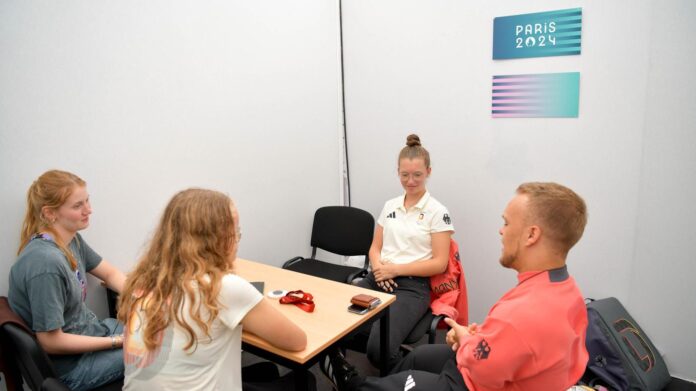More than 140 German athletes have traveled to the Paralympics in Paris. Also in the French capital: 19 young people who would like to take part in the Paralympics themselves.
Two shot put talents from the youth camp of the German Disabled Sports Youth met the best German shot putter in his class and world record holder Niko Kappel in Paris. The 29-year-old himself attended a youth camp at the 2012 London Games – and got his first taste of Paralympics.
At the meeting in the Paralympic Village, Kappel brought along the silver medal he recently won in Paris. This is in keeping with the spirit of the youth camp that has been held at the Paralympic Games since 1992 to allow young athletes to share in the “spirit” of the Games.
Two German young hopefuls in the shot put are Anna Lea Bergfeld and Hannah Magdalena Jannack. Both are 17 years old and have successfully applied to take part in the youth camp. And then they meet Kappel – someone who has made it. And who also dreamed of the world para-stage twelve years ago.
At the age of 16, Kappel took part in a youth camp run by the Württemberg Association during the London Games. He saw the band Coldplay at the closing ceremony and was enchanted by the athletics: “I really swore to myself that next time, in Rio in 2016, I would be down on the field. Not to sit up there and celebrate the others, but to take part in competitions.”
The plan worked. Four years later, he won his first Paralympic medal in Rio – gold at that. Since then, he has completed his medal set with bronze in Tokyo and silver in Paris. He shows off the silver medal when he meets the young talents Bergfeld and Jannack. Both are allowed to hold the medal in their hands while they dream of taking part in the games in Los Angeles in four years.
But the time between the youth camp and his gold medal in Rio was not easy, says Kappel. He considered giving up the sport, but then changed coaches and switched to a new technique. A constant companion in competitive sport: giving up on a “normal youth”.
The waiver remains
Kappel tells the young athletes that the sacrifices will continue throughout his career and that he still has to do a lot to deliver consistent performances: “I have to watch what I eat, I have to watch what I sleep, I have to be prepared for training and if I do those three things well, then I have 99.5% of what I need to deliver top performances,” he tells the 17-year-olds, who, in addition to attending competitions in Paris, also had a meeting with Federal President Frank-Walter Steinmeier on their agenda.
Inclusion on the training ground
Hannah Jannack trains javelin and shot put at SC Magdeburg. Due to bilateral cerebral palsy, she throws while sitting. Until recently, she trained in a group in which young Olympic and Paralympic athletes train together.

© Amrei Zieriacks / German Disabled Sports Youth
However, Kappel explains to the athletes that “the dose makes the poison” and that they shouldn’t drive themselves crazy. This is not an unfamiliar feeling for the young athletes: They also know what it’s like to have to juggle sport with being a teenager: “I’m currently preparing for my A-levels. That means I have to make sure that I get school and sport to a good level. That puts friends at the back of my mind,” says Bergfeld, who lives with one-sided cerebral palsy. She trains six times a week at BPRSV Cottbus in a para-training group.
A model that Niko Kappel supports. He advocates joint training structures in Paralympic and Olympic sports: “Cooperation between coaches is the key to more successful para-athletics in Germany in the long term,” he says. No coach can be expected to have 100 percent expertise in various disciplines: “We don’t need para-sports coaches, we need specialists in their discipline,” he adds. Kappel himself trains with a training partner who is not short. This works wonderfully: “Even in Paralympic sports, the physical laws do not change overnight” – it doesn’t matter whether you are 1.40 meters or 2.10 meters tall.
From Paris to LA
For Hannah Jannack, the games in Paris are an experience she has been looking forward to for a year: “It all feels somehow unreal, it’s just indescribable,” she said. Anna Bergfeld also soaked up the atmosphere, especially in the stadium: “It was gigantic. Not only seeing his great role models like Niko Kappel, but also all the sprinters who are winning medals and having so much fun. It was great.”
Currently, the two are still a few meters short of meeting the standard for the Paralympic Games in Los Angeles in 2028. According to Kappel, there is no need to worry: He tells them that the best age for shot put is between 28 and 34, as you are then in full possession of your athletic and technical abilities.
At the end of the meeting, Kappel has a suggestion for the young talents: “I want to take part in LA again. We’ll just go there together, okay?”
